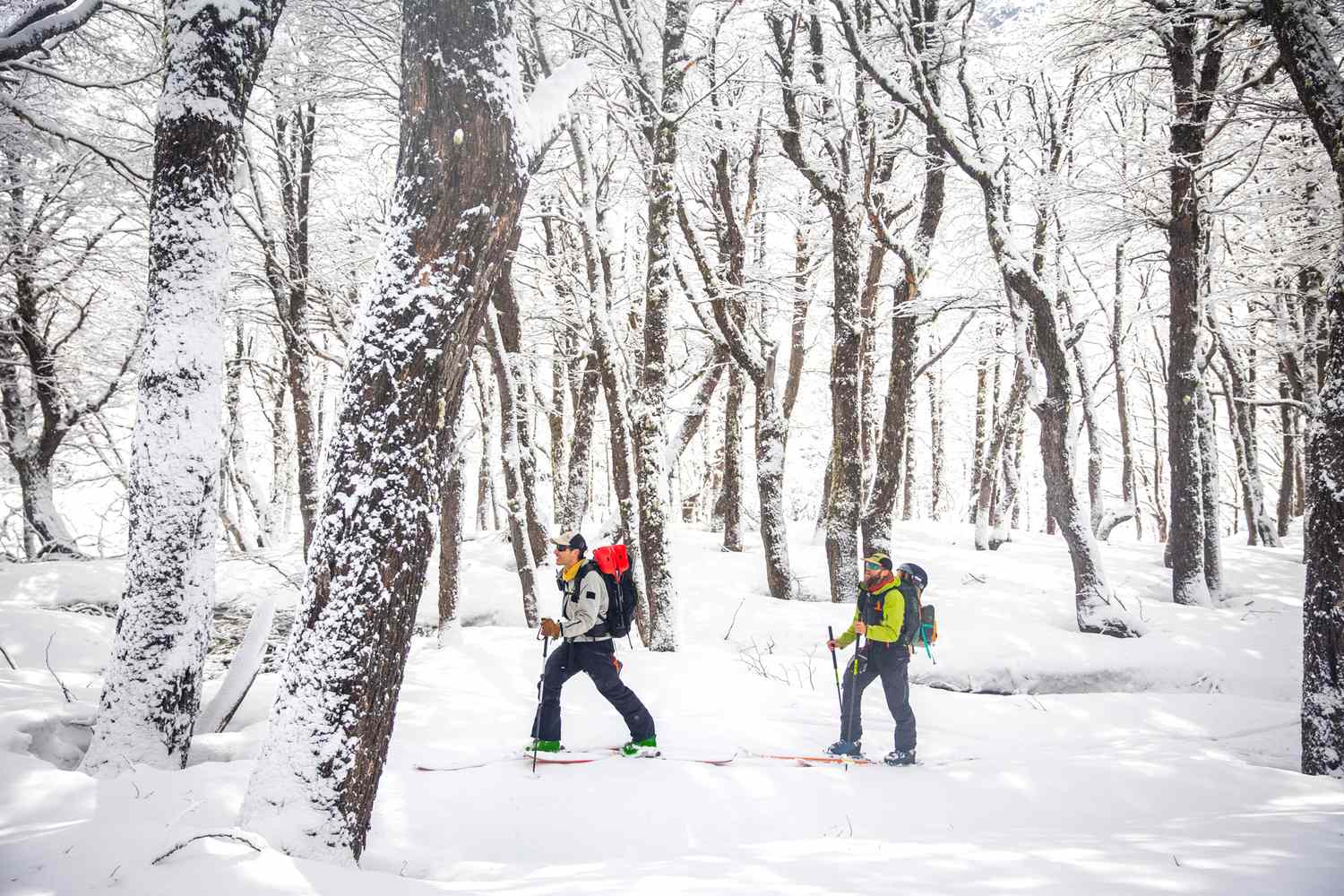:max_bytes(150000):strip_icc():format(jpeg)/TAL-skiing-from-refugio-frey-to-jakob-ARGENTINASKI1125-0f1fc77c5c9544718ec1e7871368847a.jpg)
We were standing on a wind-blasted ridge at 5,800 feet. The dark silhouette of a condor circled overhead, and we watched as it carved through a patch of blue sky. Clouds were coming in, but I still had a prime view of part of the Four Huts Traverse, the 29-mile, multiday ski route in the Argentinean region of Río Negro. I was attempting to complete the circuit with my friend Tyler Wilkinson-Ray.
It was mid-August, in the middle of South America’s ski season. Two days earlier, Tyler and I had flown in to the city of Barilochein Argentinean Patagonia. In the 1950s and 60s, a group of European immigrants built two of the four rustic huts that make up the traverse, which is within Nahuel Huapi National Park. These shelters—Frey, Laguna Negra, López, and San Martín-Jakob—are modeled on the ones found throughout the Alps.
Tyler Wilkinson-Ray
The shelters were once primarily used for summer hiking trips, when porters stocked them with food, drinks, and supplies. Winter services were lacking—until now. Skiers can arrange a stay for one or more nights and link up the huts to create a circuit in this needle-spired section of the Andes that’s famous for off-piste skiing. Besides the standard touring equipment (avalanche beacon, shovel, probe), visitors need to carry little more than a sleeping bag and a toothbrush, since dormitory-style bunks and hearty meals are provided.
On the first day of our trek, Tyler and I met our guide, Juan “Juano” José Puliafito, with whom we connected through Club Andino Bariloche—the organization of guides and hutkeepers who maintain the properties—at Catedral Alta Patagonia, one of South America’s largest ski resorts. From the top of a lift, the three of us descended 4,800 feet into a ravine that, over the course of two hours, funneled us to Refugio Frey.
Tyler Wilkinson-Ray
As a teenager, Juano’s first job was as a porter; he later became a hutkeeper, then a guide. He’d recently been awarded the concession to run Refugio Frey, and had been busy upgrading its amenities, including buying 36 new beds that had to be flown in by helicopter.
Stepping inside, we saw people huddled over wooden tables, playing cards and sharing stories of their days out in the snow. Some of them, we’d learn, were local guides, others professional athletes, and some recent college grads. The comforting aroma of pizza, topped with olives and salami and cooked in a wood-fired oven, filled the air. A hydropowered refrigerator kept the beer cold. We had arrived.
Tyler Wilkinson-Ray
We woke the next morning to find five inches of new snow on the ground. It was tempting to stay and ski the lines leading down the mountain around the hut, but we had a traverse to link up. So on we went, ascending 600 feet to Schmoll Lake, then up to a field of snow, before crossing a windy ridge and descending 1,600 feet into the Rucaco Valley on the other side. Along the way, Juano offered bits of mountaineering history and recounted legendary first ascents of the jagged peaks surrounding us.
Tyler Wilkinson-Ray
We followed a network of frozen creeks, which snaked across the expansive valley floor, to a forest of lenga trees. One of the most adaptive tree species in Patagonia, it’s able to withstand high winds, heavy snow loads, and cold temperatures. Sticky snow covered the branches, along with occasional yellow dots of llao llao, an edible fungus native to the region. We picked some and ate it straight off the bark.
Eight miles after our departure from Frey, we skied down from a ridge and crossed another frozen lake, arriving at Refugio San Martín-Jakob, which was rebuilt in 2018 following a fire. With few other guests in residence, we had plenty of room to hang our wet clothes, dry our boots, and stretch out on the floor with a foam roller. The modern, upscale building sleeps about 60 people in dormitory beds and private rooms, and even has a hot shower. Hutkeepers served us squash soup, followed by fried cutlets with potatoes and tiramisu for dessert. After consulting maps on the wall to plan out the next day’s route, the three of us settled into a deep sleep.
Tyler Wilkinson-Ray
We were up before dawn the next day, eating our cereal extra slowly to delay our departure into the howling wind we could hear blasting across the lake. But when we finally stepped outside, the air was calm, with gentle flurries floating down around us. We started our climb past Laguna de los Témpanos, or “Lake Iceberg,” which often has chunks of ice floating on its surface, and up a snow-filled chute. We followed this with a 2,000-foot descent of deep, sustained powder turns to the valley floor, each of us letting out yells of “Woohoo!” that echoed off the mountain walls. “I like when you like it!” Juano said, pleased. That run alone was worth the trip.
After a creekside lunch, drinking water straight from the source, we climbed up Navidad Ridge. All of a sudden, while scrambling across some rocks, Juano tweaked his knee and yelled out in pain. He kept moving, but as we peered down at the Laguna Negra hut, which sat on the edge of a lake, Juano’s enthusiasm turned to concern. We considered our options. If we stayed the night there and Juano’s knee continued to swell, it would be a much longer and more painful hike in the morning. If we skipped it and pushed on to bed down at the last hut, López, it would mean more miles that day, but a much smoother exit for Juano the next.
We decided on the latter, stretching an already long day into a 13-mile push that took nearly as many hours, with 7,000 feet of ups and downs. In our final miles, we switched on our headlamps. We could see the twinkling lights of Bariloche below. Somehow, Juano was cool and calm; we arrived at López late in the evening, though it was still early for dinner by Argentine standards. The welcome was warm: the hutkeeper had fresh-baked bread, quiche, and braised beef with polenta waiting for us. As we ate and replayed the day, the staff strummed a guitar and sang songs late into the night.
Tyler Wilkinson-Ray
A hefty storm was rolling in the next morning, and it became clear we’d made the right decision. Juano said his goodbyes and skied down to a bus that would to take him home to Bariloche, while Tyler and I hunkered down in the hut for a few more days.
Tyler Wilkinson-Ray
For the rest of the week, each morning brought a fresh refill of snow. We fell into a pattern of sleeping late, skiing late, and eating late as the snow kept getting better and deeper. We met local guides and avalanche forecasters, all of whom knew about the other huts, but none of whom had done the full circuit before. Unlike other parts of the world where skiers lament the growing crowds, people here were excited for others to come and experience this Andean traverse.
Refugio beds from $28 per night. Guides can be arranged through Andino Bariloche Club.





